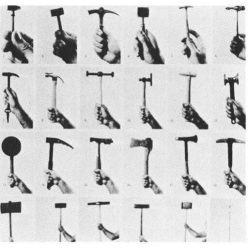- Knowing and responding to your students’ diverse needs
Writing struggles: Creating an “active” space of learning for Contextual and Theoretical Studies
Contextual background:
CTS3 is the final dissertation unit for all undergraduate students in the Design School at LCC. The dynamics of CTS3 is different to their other CTS units: students need to be ‘in charge’ of their own learning, planning and developing their research project over the course of 14 weeks, with the final submission being a 8-10,000 word dissertation. Students work in small groups of 8 and meet for a weekly 2hr seminar.
Evaluation:
While the aim of the small group setting in CTS3 is to facilitate peer discussion, exchange and active learning, over the last 3 years I have observed how students struggle to bond with each other, making the group dynamics and discussions quite tenuous. The tutor is seen as the authority, and peer discussion is given little value.
Some challenges are given by: different levels of ability and confidence with research and writing; social anxiety caused by mixing of all 8 UG courses; different starting points with some students having barely a ‘sketch’ of an idea for their research projects, others having fully formed research questions; different learning styles so some struggle with ‘active’ writing sessions and may need more time for reflection, silence, contemplation, reading etc. My aim is to set these weekly sessions up as a reflective space of peer exchange where students learn from each-other.
Moving Forwards:
Acknowledging difference and positionality
Students will often discuss their struggles/insecurities in a 1-2-1 setting, but I think it is important to acknowledge each student’s difference of experience, knowledge, interests and positionality in our first session. This may be done through a writing/reflective exercise and will position difference as a core value of CTS3.
Rather than going over the assignment brief – which we can run as a school-wide briefing session in the lecture theatre – the first seminar can therefore be used to engage with students as individual learners, emphasising and empathising with their personal narratives, centring their perspectives at the core of the unit. This might set a different tone and create a more compassionate and caring group dynamics. Foregrounding care as a starting point for academic development, this would also challenge hierarchies and foster trust (Compton and Lindner, 2022).
Communities of practice
While it would be great for students to be able to develop relationships across courses, the x-school model does not work. Students don’t have the time or the emotional energy to connect with each other when they are only together for 2hrs every week, so rather than emphasising this diversity perhaps we need to build more consistent communities of practice: groups of tutors working with students within a course/group of courses that are aligned in terms of their disciplinary focus. This might enable students to bond more easily through a shared vocabulary, knowledge, approach to research. This goes against our ‘idealised’ notion of cross-fertilisation and interdisciplinary collaboration but recognises the importance of situatedness of student experience.
Reconsidering what is active learning?
Active learning through writing is often emphasised in CTS3 delivery. I’ve often handed out worksheets to facilitate this and while students have appreciated the structure of such sessions, I have also found it hampers group discussion/engagement. Empty sheets vs fully filled out sheets seem to be indicative of ‘participation’ and ‘engagement’, but this does not account for different learning styles. Going forward, I will devise activities that give value to silences, listening and contemplation as an ‘active’ form of learning (Su, Wood, Tribe, 2023), exploring silence as a creative practice (Cage, 1978) and building space for slowness and reflection into what can sometimes be a ‘manic’ 2hr session. It might also mean taking the class out of the classroom, seeing ‘research in practice’ and seeking ‘nourishment’ outside the university walls: as observation in the park, as a walk through a gallery space, as a recording of conversations in a café (Bell, 2022). This will also acknowledge different cultures of learning within CTS3 groups and decentre ‘writing’ as being the sole aim of CTS3.
References:
Ahsan, H. (2017) Shy Radicals: The Antisystemic Politics of the Militant Introvert. London: Book Works
Bell, R. (2022) Untrammelled ways: Reflecting on the written text, nourishment and care in online teaching. Journal of Writing in Creative Practice, Vol. 15 (2), 126-138.
Cage, J (1978) Silence: Lectures and Writings. Wesleyan University Press
Compton, M., Lindner, R. (2022) A Pedagogy of care (hu)manifesto. Freedom to Learn. Available online: https://reflect.ucl.ac.uk/mcarena/2022/12/08/care/
Denial, C. (2019) A pedagogy of kindness. Hybrid Pedagogy. Available online:
https://hybridpedagogy.org/pedagogy-of-kindness/
Su, F., Wood, M., Tribe, R. (2023), ‘Dare to be silent’: Re-conceptualising silence as a positive pedagogical approach in schools, Research in Education, Vol. 116 (1), 29-42.
